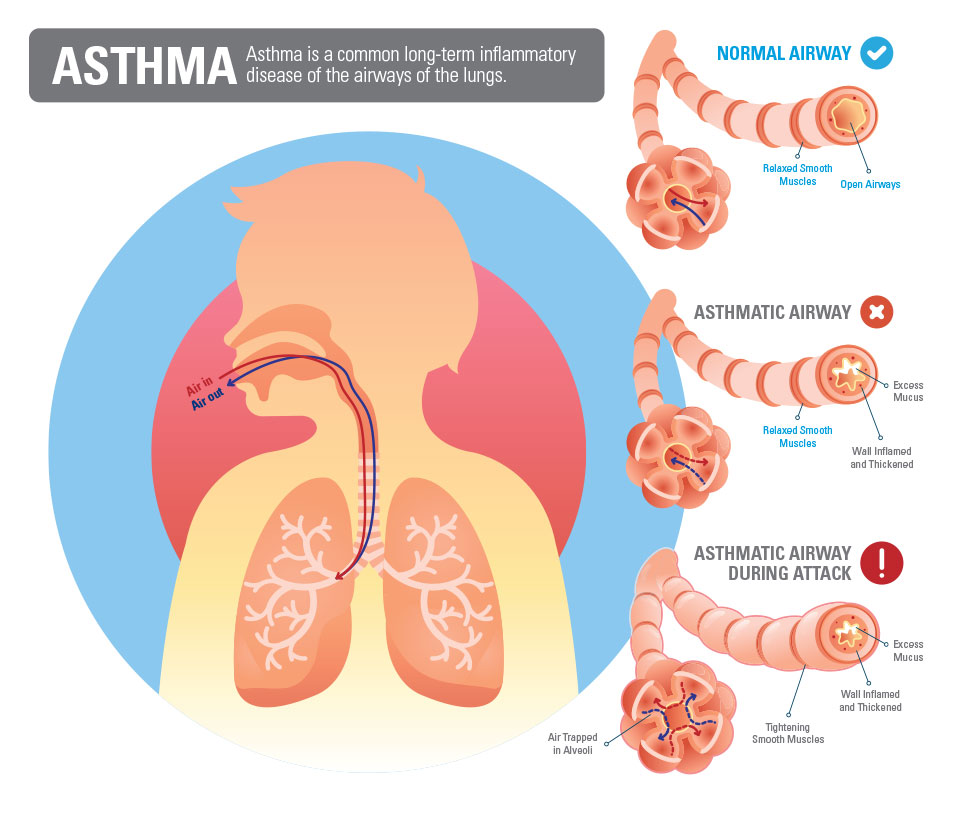Chronic obstructive asthma, often referred to as a combination of asthma and chronic obstructive pulmonary disease (COPD), is a complex respiratory condition that can significantly affect a person’s quality of life. It is essential to understand the nature of this condition, its symptoms, underlying causes, and treatment options. In this guide, we provide a comprehensive overview to help you better understand chronic obstructive asthma and its management.

What is Chronic Obstructive Asthma?
Chronic obstructive asthma is a term used to describe a condition where asthma symptoms are exacerbated by chronic airflow limitation, resembling the symptoms of COPD. While asthma primarily involves inflammation and narrowing of the airways due to triggers like allergens and irritants, chronic obstructive asthma combines these features with persistent lung damage, which can lead to breathing difficulties over time.
The hallmark of chronic obstructive asthma is the presence of both asthma and COPD-like symptoms. It involves recurrent episodes of wheezing, breathlessness, and coughing, which can occur more frequently than in typical asthma. Over time, the lung function may decline, causing more severe and chronic symptoms that require careful management.
Symptoms of Chronic Obstructive Asthma
The symptoms of chronic obstructive asthma can vary in severity and may overlap with those of asthma and COPD. Key symptoms include:
- Wheezing: A high-pitched whistling sound when breathing, particularly during exhalation.
- Shortness of breath: Difficulty breathing, especially during physical activities or at night.
- Chronic cough: Persistent coughing, often worse in the morning or at night.
- Increased mucus production: Excess mucus may lead to more frequent coughing and difficulty breathing.
- Chest tightness: A feeling of pressure or constriction in the chest.
It is important to note that these symptoms can fluctuate over time. Episodes may worsen due to triggers such as allergens, smoke, cold air, or respiratory infections.
Causes and Risk Factors of Chronic Obstructive Asthma
The exact causes of chronic obstructive asthma are not entirely understood, but several factors can contribute to the development of this condition. These include:
- Genetic predisposition: A family history of asthma or COPD increases the likelihood of developing chronic obstructive asthma.
- Environmental factors: Exposure to environmental pollutants, tobacco smoke, and allergens can trigger the onset of asthma symptoms and contribute to lung damage over time.
- Airway inflammation: Chronic inflammation of the airways, commonly seen in asthma, can lead to remodeling of the airway structure, making them more prone to narrowing and obstruction.
- Occupational exposures: Certain occupations that involve exposure to dust, fumes, or chemicals may increase the risk of developing chronic obstructive asthma.
- Respiratory infections: Frequent respiratory infections, particularly in childhood, may increase the risk of developing asthma or worsen existing symptoms.
The Link Between Asthma and COPD
Although asthma and COPD are distinct conditions, they share common symptoms and can overlap in some individuals. While asthma is typically diagnosed in childhood and involves reversible airway obstruction, COPD generally occurs later in life and is characterized by irreversible airflow limitation.
In chronic obstructive asthma, the combination of both conditions can lead to progressive lung damage. Asthma medications may not always control symptoms, and COPD treatments may be necessary to manage chronic airflow obstruction.
Diagnosing Chronic Obstructive Asthma
Diagnosing chronic obstructive asthma involves a combination of medical history, physical examination, and several diagnostic tests, including:
- Pulmonary function tests (PFTs): These tests measure lung function by assessing how much air you can inhale and exhale, as well as how efficiently your lungs move air.
- Spirometry: A type of pulmonary function test that evaluates the volume of air exhaled after a deep breath. It helps determine the degree of airflow limitation.
- Chest X-rays or CT scans: Imaging tests that can help detect lung damage, structural changes, and inflammation.
- Exhaled nitric oxide test: This test measures the level of nitric oxide in exhaled breath, which is an indicator of inflammation in the airways.
Accurate diagnosis is essential to differentiate chronic obstructive asthma from other respiratory diseases and to create an effective treatment plan.
Treatment and Management of Chronic Obstructive Asthma
Managing chronic obstructive asthma requires a combination of medications, lifestyle changes, and strategies to prevent flare-ups. The goal of treatment is to reduce symptoms, improve lung function, and prevent further lung damage.
Medications
The primary treatment for chronic obstructive asthma includes both asthma and COPD medications. These may include:
- Inhaled corticosteroids (ICS): These medications reduce airway inflammation and help prevent asthma symptoms.
- Long-acting beta-agonists (LABAs): These medications help relax the muscles around the airways and keep them open for longer periods.
- Combination inhalers: These inhalers contain both corticosteroids and long-acting bronchodilators, making them effective in managing both asthma and COPD symptoms.
- Short-acting bronchodilators: These medications provide quick relief from wheezing and shortness of breath by opening the airways.
- Phosphodiesterase-4 inhibitors (PDE4 inhibitors): Used to reduce inflammation and relax the airways in COPD patients.
- Oxygen therapy: In cases of severe airflow limitation and low blood oxygen levels, oxygen therapy may be recommended.
Lifestyle Modifications
- Smoking cessation: Smoking is a major cause of COPD, and quitting is essential to prevent further damage to the lungs.
- Physical activity: Regular exercise helps improve lung function and reduces symptoms, though it should be done under medical supervision.
- Avoiding triggers: Identifying and avoiding asthma triggers, such as allergens and irritants, is crucial in managing symptoms.
- Healthy diet: A balanced diet can support lung health and overall well-being. Nutritional deficiencies can worsen respiratory symptoms.
Pulmonary Rehabilitation
For those with more severe chronic obstructive asthma, pulmonary rehabilitation may be recommended. This program includes physical exercises, breathing techniques, and education about managing symptoms and improving quality of life.
Complications of Chronic Obstructive Asthma
If left untreated, chronic obstructive asthma can lead to several complications, including:
- Exacerbations: Acute worsening of symptoms that require medical intervention.
- Respiratory failure: Severe airflow limitation may result in inadequate oxygen supply to the body.
- Heart problems: Chronic lung disease can put additional strain on the heart, leading to complications such as right-sided heart failure (cor pulmonale).
- Increased risk of infections: Individuals with chronic obstructive asthma are more susceptible to respiratory infections, which can worsen symptoms and lead to further complications.
Preventing Chronic Obstructive Asthma Exacerbations
Preventing exacerbations is an essential aspect of managing chronic obstructive asthma. Strategies include:
- Adhering to medication regimens: Ensuring consistent use of prescribed medications can help prevent flare-ups and improve symptom control.
- Monitoring symptoms: Regular monitoring of symptoms and lung function can help detect early signs of exacerbation and prompt treatment.
- Vaccinations: Receiving vaccinations against flu and pneumonia can help reduce the risk of respiratory infections that may exacerbate symptoms.
- Maintaining a clean indoor environment: Reducing exposure to indoor allergens and pollutants can help manage asthma symptoms.

